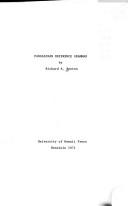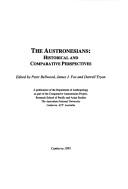| Listing 1 - 10 of 14 | << page >> |
Sort by
|
Book
Year: 2018 Publisher: Honolulu : University of Hawai'i Press,
Abstract | Keywords | Export | Availability | Bookmark
 Loading...
Loading...Choose an application
- Reference Manager
- EndNote
- RefWorks (Direct export to RefWorks)
Almost one quarter of the world's languages are (or were) spoken in the Pacific, making it linguistically the most complex region in the world. This book introduces the grammatical features and semantic structures of Oceanic, Papuan, and Australian languages. It places them in their historical and geographical context, discusses the linguistic evidence for the settlement of the Pacific, and speculates on the reason for the region's many languages. It devotes considerable attention to the effects of contact between speakers of different languages and to the development of pidgin and creole languages in the Pacific.
Periodical
ISSN: 26566419 08549613
Abstract | Keywords | Export | Availability | Bookmark
 Loading...
Loading...Choose an application
- Reference Manager
- EndNote
- RefWorks (Direct export to RefWorks)
Linguistics --- Malayan languages --- Austronesian languages --- Linguistique --- Langues indonésiennes --- Langues austronésiennes --- Austronesian languages. --- Linguistics. --- Malayan languages. --- Hesperonesian languages --- Indonesian languages --- Western Austronesian languages --- Linguistic science --- Science of language --- Language and languages --- Malay-Polynesian languages --- Malayo-Polynesian languages
Book
ISBN: 9004286691 9004286071 9789004286696 9789004286078 Year: 1964 Publisher: Brill
Abstract | Keywords | Export | Availability | Bookmark
 Loading...
Loading...Choose an application
- Reference Manager
- EndNote
- RefWorks (Direct export to RefWorks)
Indonesia
Uma language. --- Malayan languages. --- Hesperonesian languages --- Indonesian languages --- Western Austronesian languages --- Austronesian languages --- Oema language --- Pipikoro language --- Uma Aria language --- Toraja languages --- Language and languages --- indonesia
Book
ISBN: 3961101086 3961101094 9783961101085 9783961101092 Year: 2018 Publisher: Berlin Language Science Press
Abstract | Keywords | Export | Availability | Bookmark
 Loading...
Loading...Choose an application
- Reference Manager
- EndNote
- RefWorks (Direct export to RefWorks)
Information structure is a relatively new field to linguistics and has only recently been studied for smaller and less described languages. This book is the first of its kind that brings together contributions on information structure in Austronesian languages. Current approaches from formal semantics, discourse studies, and intonational phonology are brought together with language specific and cross-linguistic expertise of Austronesian languages. The 13 chapters in this volume cover all subgroups of the large Austronesian family, including Formosan, Central Malayo-Polynesian, South Halmahera-West New Guinea, and Oceanic. The major focus, though, lies on Western Malayo-Polynesian languages. Some chapters investigate two of the largest languages in the region (Tagalog and different varieties of Malay), others study information-structural phenomena in small, underdescribed languages. The three overarching topics that are covered in this book are NP marking and reference tracking devices, syntactic structures and information-structural categories, and the interaction of information structure and prosody. Various data types build the basis for the different studies compiled in this book. Some chapters investigate written texts, such as modern novels (cf. Djenar’s chapter on modern, standard Indonesian), or compare different text genres, such as, for example, oral narratives and translations of biblical narratives (cf. De Busser’s chapter on Bunun). Most contributions, however, study natural spoken speech and make use of spoken corpora which have been compiled by the authors themselves. The volume comprises a number of different methods and theoretical frameworks. Two chapters make use of the Question Under Discussion approach, developed in formal semantics (cf. the chapters by Latrouite & Riester; Shiohara & Riester). Riesberg et al. apply the recently developed method of Rapid Prosody Transcription (RPT) to investigate native speakers’ perception of prosodic prominences and boundaries in Papuan Malay. Other papers discuss theoretical consequences of their findings. Thus, for example, Himmelmann takes apart the most widespread framework for intonational phonology (ToBI) and argues that the analysis of Indonesian languages requires much simpler assumptions than the ones underlying the standard model. Arka & Sedeng ask the question how fine-grained information structure space should be conceptualized and modelled, e.g. in LFG. Schnell argues that elements that could be analysed as “topic” and “focus” categories, should better be described in terms of ‘packaging’ and do not necessarily reflect any pragmatic roles in the first place.
Lingüística --- Austronesian languages --- Syntax. --- Malay-Polynesian languages --- Malayo-Polynesian languages --- Linguistics

ISBN: 0870220721 0824879104 9780824879112 Year: 1971 Publisher: Honolulu, Hawaii University of Hawaii Press
Abstract | Keywords | Export | Availability | Bookmark
 Loading...
Loading...Choose an application
- Reference Manager
- EndNote
- RefWorks (Direct export to RefWorks)
Grammar --- Austronesian languages --- Pangasinan language --- Grammar. --- Philippine languages --- Pangasinan language. --- Language teaching & learning
Book
Year: 2017 Publisher: John Benjamins Publishing Company
Abstract | Keywords | Export | Availability | Bookmark
 Loading...
Loading...Choose an application
- Reference Manager
- EndNote
- RefWorks (Direct export to RefWorks)
This volume presents five variants of the Imdeduya myth: two versions of the actual myth, a short story, a song and John Kasaipwalova’s English poem “Sail the Midnight Sun”. This poem draws heavily on the Trobriand myth which introduces the protagonists Imdeduya and Yolina and reports on Yolina’s intention to marry the girl so famous for her beauty, on his long journey to Imdeduya’s village and on their tragic love story. The texts are compared with each other with a final focus on the clash between orality and scripturality. Contrary to Kasaipwalova’s fixed poetic text, the oral Imdeduya versions reveal the variability characteristic for oral tradition. This variability opens up questions about traditional stability and destabilization of oral literature, especially questions about the changing role of myth – and magic – in the Trobriand Islanders' society which gets more and more integrated into the by now “literal” nation of Papua New Guinea.
Legends --- Trobriand Islands (Papua New Guinea) --- Anthropological linguistics --- Austronesian languages --- Narrative studies --- Linguistics --- Anthropology
Periodical
Year: 2004 Publisher: Milwaukee, WI : [Santa Barbara, Calif.] : University of Wisconsin--Milwaukee, University of California, Santa Barbara
Abstract | Keywords | Export | Availability | Bookmark
 Loading...
Loading...Choose an application
- Reference Manager
- EndNote
- RefWorks (Direct export to RefWorks)
Tibeto-Burman languages --- Dravidian languages --- Austronesian languages --- Indo-Aryan languages --- Himalaya Mountains Region --- Himalaya Mountains Region. --- Languages --- Linguistics --- Periodicals --- Language and languages --- South Asia
Book
ISBN: 9027202877 9786613314789 1283314789 9027284695 Year: 2011 Publisher: Amsterdam ; Philadelphia : John Benjamins Pub. Co.,
Abstract | Keywords | Export | Availability | Bookmark
 Loading...
Loading...Choose an application
- Reference Manager
- EndNote
- RefWorks (Direct export to RefWorks)
The Trobriand Islanders' eschatological belief system explains what happens when someone dies. Bronislaw Malinowski described essentials of this eschatology in his articles ""Baloma: the Spirits of the Dead in the Trobriand Islands"" and ""Myth in Primitive Psychology"". There he also presented the Trobrianders' belief that a ""baloma"" can be reborn; he claimed that Trobrianders are unaware of the father's role as genitor. This volume presents a critical review of Malinowski's ethnography of Trobriand eschatology - finally settling the ""virgin birth"" controversy. It also documents the ritua
Kiriwinian language. --- Language. --- Trobriand Islands (Papua New Guinea) -- Languages. --- Kiriwinian language --- Languages & Literatures --- Austronesian, Papuan & Australian Languages & Literatures --- Trobriand Islands (Papua New Guinea) --- Languages. --- Kilivila language --- Trobriand language --- Melanesian languages --- Kitava language --- Antropological linguistics --- Austronesian languages --- Linguistics --- Anthropology
Book
ISBN: 9004286322 9067652326 9789401768146 9789004286320 9789004286320 9789067652322 Year: 1988 Publisher: Brill
Abstract | Keywords | Export | Availability | Bookmark
 Loading...
Loading...Choose an application
- Reference Manager
- EndNote
- RefWorks (Direct export to RefWorks)
Language: history and general works
Wolio language --- Malayan languages. --- Austronesian languages. --- Grammar. --- Indonesia --- Languages. --- Malay-Polynesian languages --- Malayo-Polynesian languages --- Hesperonesian languages --- Indonesian languages --- Western Austronesian languages --- Austronesian languages --- Malayan languages --- Wolio language. --- Language and languages. --- Indonesia. --- Foreign languages --- Languages --- Anthropology --- Communication --- Ethnology --- Information theory --- Meaning (Psychology) --- Philology --- Linguistics --- Dutch East Indies --- Endonèsie --- Indanezii͡ --- Indoneshia --- Indoneshia Kyōwakoku --- Indonesi --- Indonesya --- Indonezia --- Indonezii͡ --- Indonezija --- İndoneziya --- İndoneziya Respublikası --- Indūnīsīy --- Induonezėj --- Jumhūrīyah Indūnīsīy --- PDRI --- Pemerintah Darurat Republik Indonesia --- R.I. --- Republic of Indonesia --- Republic of the United States of Indonesia --- Republica d'Indonesia --- Republiek van Indonesi --- Republik Indonesia --- Republik Indonesia Serikat --- Republika Indonezii͡ --- Republika Indonezija --- Rėspublika Indanezii͡ --- RI --- United States of Indonesia --- Yinni --- Dutch East Indies (Territory under Japanese occupation, 1942-1945) --- Indanezii︠a︡ --- Indonesië --- Indonezii︠a︡ --- Indūnīsīyā --- Induonezėjė --- Jumhūrīyah Indūnīsīyā --- Republiek van Indonesië --- Republika Indonezii︠a︡ --- Rėspublika Indanezii︠a︡ --- Language: history & general works

ISBN: 0731521323 1920942858 9781920942854 9780731521326 Year: 2006 Publisher: Canberra, Australian Capital Territory : ANU E Press,
Abstract | Keywords | Export | Availability | Bookmark
 Loading...
Loading...Choose an application
- Reference Manager
- EndNote
- RefWorks (Direct export to RefWorks)
Austronesian languages --- Comparative civilization --- Prehistoric peoples --- Austronesian, Papuan & Australian Languages & Literatures --- Malay-Polynesian languages --- Malayo-Polynesian languages --- Pacific Ocean Islands --- Cavemen (Prehistoric peoples) --- Early man --- Man, Prehistoric --- Prehistoric archaeology --- Prehistoric human beings --- Prehistoric humans --- Prehistory --- Human beings --- Antiquities, Prehistoric --- Islands of the Pacific --- Southeast Asia --- Asia, Southeast --- Asia, Southeastern --- South East Asia --- Southeastern Asia --- Pacific Islands --- Civilization --- Primitive societies
| Listing 1 - 10 of 14 | << page >> |
Sort by
|

 Search
Search Feedback
Feedback About UniCat
About UniCat  Help
Help News
News